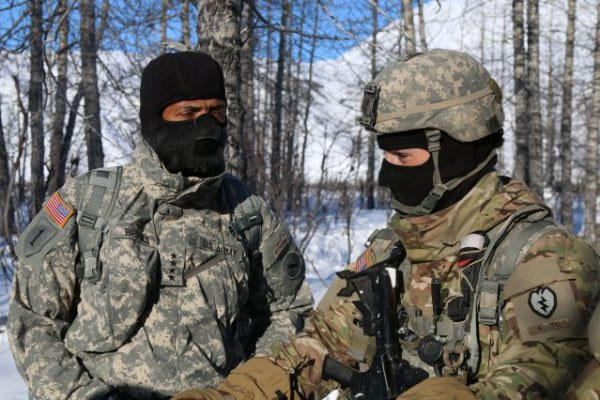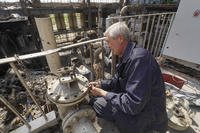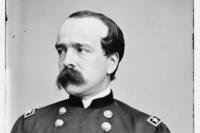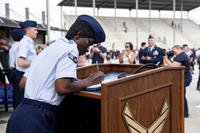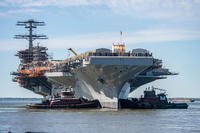Maj. Gen. Bryan Owens, commander of U.S. Army Alaska, has a make-or-break training exercise next month that will weigh heavily on whether his forces decreases in strength from 11,000 to 9,000 troops.
"This is important to us," he said Wednesday of the airborne exercise expected to begin on Feb. 16. "I don't know what we're going to come down to" in terms of end strength. "We may lose up to 2,000 troops in the process here."
The exercise will be conducted by the 4th Brigade Combat Team (Airborne) of the 25th Infantry Division, based at Joint Base Elmendorf-Richardson near Anchorage, which is the only airborne brigade combat team assigned to U.S. Pacific Command.
The current plan would have the 4th BCT come down to battalion size as the Army moves to cut active-duty end-strength to 450,000 in 2018. But Sen. Dan Sullivan, a Republican from Alaska, has used Senate hearings as a forum to argue the case for making an exception for the units in the state.
Army Chief of Staff Gen. Mark Milley has told Sullivan that he will not make any recommendations on sizing the brigade until he evaluates the exercise at the Joint Regional Training Center at Fort Polk, Louisiana, Owens said.
"The JRTC rotation figures into it -- that's fair to say," Owens said. "We're doing the jump Feb. 16," he said. Afterwards, he said, "We will validate this airborne task force and their ability to do a joint forcible entry operation."
He added, "That is where the chief of staff of the Army is going to use the feedback from this particular event to make this decision. That is one of the key pieces that will build towards this decision. I've got 11,000 now. What are we going down to? I don't know."
In a video briefing, which he conducted outside of Fort Wainwright, Owens spoke a day before the National Commission on the Future of the Army was to release its report on the size and force mixture of the service's active and reserve components. The congressionally mandated panel has also been tasked with making recommendations on possible modifications to the Army's downsizing plan.
The commission, led by retired army Gen. Carter F. Ham and including former sergeant Major of the Army Raymond Chandler and former Pentagon Comptroller Bob Hale, was also charged with making an assessment of the highly charged proposal to transfer AH-64 Apache attack helicopters from the Army National Guard to the active duty Army.
Sullivan, a lieutenant colonel in the Marine Corps reserves and former Alaska attorney general, has made much of the growing Russian threat in the Arctic to argue against cuts for Army units in the state. He has said he will attend the training exercise in Louisiana next month.
In an interview last month with the Alaska Journal of Commerce, Sullivan said the Russians "have positioned four brigade-size combat teams and built 11 new airfields in the Arctic, as well as installing a sophisticated new air defense system and commissioning 40 new icebreakers, some of them nuclear."
He said, "What are we doing? Squat. And at the same time we're talking about withdrawing the only airborne combat brigade in the Pacific."
Owens acknowledged, "We do know what the Russians are doing -- they're building up their Arctic brigades. That does not affect how we do our training. So we don't train specifically against a certain threat, we train against any threat." He noted that USARAK partners for exercises in the region with other nations bordering the Arctic, "minus Russia."
Behind Owens as he spoke, troops were skiing down a slope, some more successfully than others. He said the troops were among 230 soldiers competing as 10-man teams for the title of "most proficient Arctic Warrior."
The competition included pulling a 300-pound "akhio" -- the small Alaskan sled used to haul supplies and evacuate casualties, Owens said. "A team of soldiers strap themselves to the sled and pull while also carrying all the gear, weapons and full ruck sacks that soldiers normally wear when ruck marching," he said.
There was also competition in "skijoring" -- lining up on skis behind a tracked vehicle's towline for quick movement, Owens said. It was 14 degrees where he was at Fort Wainwright, near Fairbanks, Owens said, but "normally it's minus 25," he said.
In the extreme cold, "things slow down, you can't move as fast," Owens said. Communications become problematic as units move farther north, he said. "Communications are very difficult in Alaska because of the look angles of the satellites and so we're going to test out some of our ability in the far north -- test our ability to communicate," he said.
Owens said, "We don't go to a cold weather training range. We live in it." The experiences involves "learning how to survive, we learn how there's a lot of nuances to fighting in this type of weather," he said.
One of those nuances entailed getting his troops accustomed to leaving their weapons outside the tent when they go in to warm up because of the way metals are affected by extreme cold, Owens said.
"What really changes is the consistency of your metals," he said. "You've got to cold soak your metals, get them out in the cold. You cannot take your weapons into the warming tent -- even for a few minutes. You come back outside, the metal sweats. It immediately freezes and your trigger mechanism will not work. Something as simple as that."
The cold can even affect "something as simple as taking up a sight picture with your weapon. If your nose accidentally touches the charging handle, the metal charging handle, you'd get instant frostbite," Owens said, "That is something we train our troops to understand -- how to function with the metals."
Owens, an Iraq veteran who took command of USARAK last July and most recently served as director of Joint Operations, U.S. European Command, said his mortars crews also have to be cautious in the cold.
"The heat from the rounds can actually crack the base (plates) and so you have to be very careful that you don't push too many rounds out of the tubes," he said.
-- Richard Sisk can be reached at Richard.Sisk@Military.com.
